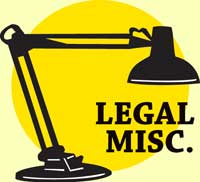Legal Issues Pertaining to Sweeping

Legal Issues Pertaining to Sweeping |
 |
U.S. Sweeper Noise Regs Explained... And More
Recently, we received an inquiry from an employee of the New York State Department of Transportation. He wrote in asking if we could provide the agency with current sweeper noise regulations for inside the cab, as well as outside at the sweeper itself. Thanks to Brian Giles, at Elgin, for providing us with the following current OSHA/NIOSH baseline information."There is not a specific sweeper standard," wrote Giles. "The user requirement is typically driven by the workplace standard, OSHA or NIOSH. You can see by the attached graph where it indicates daily exposure limits.
"It simply means that if they are going to be exposed, they should wear hearing protection. Now that is the exact answer to the question, but let me point out a great source of industry mis-information and confusion. These OSHA numbers refer to sound levels at the operator ear. Not sound levels at a given distance from the machine or the European sound power directive measurements. "These are completely different numbers that are measured in different ways. The type test utilized by Elgin is the operator Ear Sound Test, called SAE J919. SAE J919 is performed by measuring the sound pressure at the position of an average operatorŐs ear in the sweeper cab. Typically, the test is performed with the windows open and the windows closed." For those who want the technical details...Many people do not realize that finding a way to decrease the decibels even by a few numbers makes a bid difference. The secret lies in the fact that the decibel scale is logarithmic, not linear. You may be familiar with logarithmic scales in the terminology of earthquakes: a quake of 6 on the Richter logarithmic scale is 10 times stronger than a quake of Richter 5, and a quake of Richter 7 is 100 times as severe as a 5. Thus, the 8.5 quake that occurred in Chile a few years back was 1000 times stronger than the equivalent Richter 5.5 of the Hiroshima atomic bomb. Like the Richter scale, the decibel scale (named after Alexander Graham Bell – which is why the "B" in the abbreviation dB is capitalized) is a "base ten" logarithmic scale. What it describes are ratios of sound pressure levels. The sound pressure is the level measured per unit area at a particular location relative to the sound source – in other words, sound pressure is what the complaining neighbor hears, or what an inspecting police officer might measure at a legally determined distance from your machine, expressed in decibels: dB = 20 log (p1/p0) where dB is the decibel reading, p1 is the sound pressure at that location, and p0 is the threshold of hearing. ("Log" is a function such that if log y = x, then 10 raised to the power of x = y.) For example, when the officer informs you that your equipment is putting out 79 decibels, that means the racket is approximately 10,000 times louder than the threshold of normal hearing in a young, undamaged ear. In plain English, this equation tells us that each increase of six decibels means the noise level has approximately doubled – or, conversely, knocking only six decibels off your sound pressure will reduce your noise output by half, no matter where you're starting on the decibel scale. Lowering your current decibel level by 12 reduces your sound output to one fourth its original level, while a 20 decibel improvement means you're only one tenth as loud. Decibel Levels in the Real World
140-------------------------------------------------------------------------------------------------------
Pain Shotgun blast; jet taking off 100 ft. away
Firecrackers; severe thunder; pneumatic jackhammer
120-------------------------------------------------------------------------------------------------------
Uncomfortably Rock Music; hockey crowd
loud Concorde jet or 707 jet landing 370 ft. away
100-------------------------------------------------------------------------------------------------------
Loud 707 jet taking off 1000 ft. away, gas lawn mower 3 ft. away
Diesel truck 50 ft. away; food blender or garbage disposal 3 ft. away
80-------------------------------------------------------------------------------------------------------
Moderately 747 jet taking off 1000 ft. away, vacuum cleaner 10 ft. away
loud Commercial area; normal speech 3 ft. away; quiet typewriter
60-------------------------------------------------------------------------------------------------------
Quiet Quiet urban daytime streets, dishwasher in next room
Quiet urban nightime streets, household refrigerator
40-------------------------------------------------------------------------------------------------------
Very Quiet suburban nighttime streets, library, average home
quiet Quiet rural areas or bedroom at night
20-------------------------------------------------------------------------------------------------------
Just Rustling leaves, whisper
audible Threshold for acute hearing
0-------------------------------------------------------------------------------------------------------
...And Here's What You Can Do To Mitigate Noise
Our advice is to also let your client know right away when you have had a complaint. Most who are upset enough to stop you or call the police will also call the mall manager. They will appreciate knowing about it first from you, so they can be prepared. Handling this type of situation well is very much in their own self interest. Although they don't want unhappy neighbors, they also aren't going to want to pay the extra costs that noise and/or time restrictions usually bring, either. Knocking only six decibels off your sound pressure will reduce your noise output by half.Steps you might take to reduce sweeper noise and/or complaints:
If you have comments or further information on this article, please let us know. |
© 2005 - 2022 World Sweeper
|
Legal Issues Contents
|